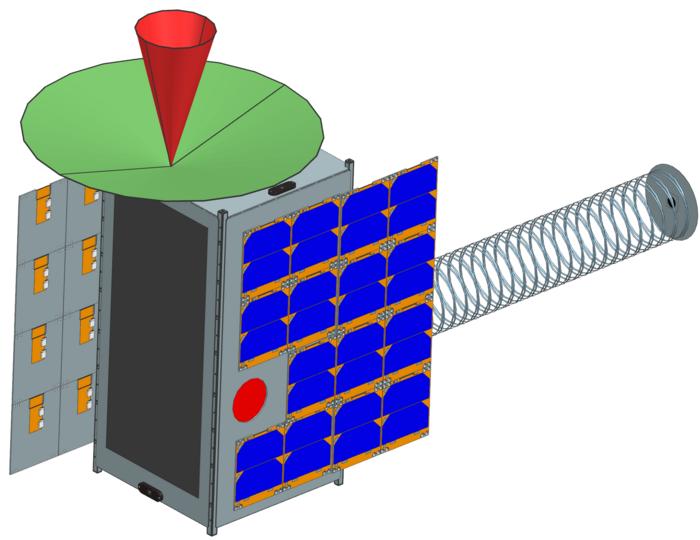How the Sun influences the atmosphere, space weather and habitability of a planet, as well as the space between the stars, could be investigated by two proposed UK space missions, led by the University of Leicester.

Credit: University of Leicester
How the Sun influences the atmosphere, space weather and habitability of a planet, as well as the space between the stars, could be investigated by two proposed UK space missions, led by the University of Leicester.
A total of nearly £500,000 funding has been granted by the UK Space Agency to two teams based at Space Park Leicester, the University of Leicester’s £100 million science and innovation park. It will support scientists in developing the proposals for two satellites that would examine in two different ways how activity in a star’s corona, such as the solar wind, impacts their planets and the environment in which they orbit.
Stellar winds can directly affect exo-planetary environments and control the flow of material and flux of cosmic rays from the Galactic environment, which have a potential influence on planetary climate. Stars also recycle material back into the interstellar medium – the matter and radiation that exists in the space between the star systems – enriching Galactic metal content.
These processes can tell us a great deal about the habitability of a star system’s planets and the evolution of stars and galaxies, but are currently poorly understood.
SIRIUS, which has received £295,200 funding, is a high resolution extreme ultraviolet (EUV) spectroscopy instrument that would perform a wide range of astrophysical studies of nearby stars and the interstellar medium (ISM). Hot gases in the 105-107 kelvin range are associated with these processes and can be efficiently investigated in the EUV range, which is not covered by any other existing or planned instrument.
SIRIUS would perform unique EUV spectroscopy to diagnose the density, temperature, composition, structure, and dynamics of these hot astrophysical plasmas in the coronal activity of stars in our neighbourhood. It could also be used in combination with other exoplanet-hunting missions to better understand the interactions between stars and their interplanetary environment, as well as the potential habitability of planets that orbit them.
Professor Martin Barstow said: “SIRIUS is a very exciting mission scientifically, but also shows UK leadership in a pioneering approach to lowering the cost of space science. SIRIUS could be the first UK-led space science mission since Ariel 6 in 1979.”
“A very important part of this project is working closely with our industrial partners, Oxford Space Systems and In-Space Missions. They will provide novel systems that enable us to deliver cost-effective high quality science.”
SIRIUS is an international proposal with the University of Leicester as the lead institution. The spectrograph will be provided by a consortium led by the University of Leicester, including contributions from Germany (University of Tubingen), Spain (Complutense University, Madrid) and Belgium (University of Liege). A partnership with the UAE (University of Sharjah) is being developed. Support for development of the science programme is being delivered by the University of Cambridge and the Open University. The spacecraft and operations will be provided by In-Space Missions, a wholly owned subsidiary of BAE Systems Digital Intelligence. A telescope deployment system, allowing launch of a compact telescope package will be provided by Oxford Space Systems.
Elfen would train its focus closer to home by exploring the Earth’s magnetosphere, the region of space around the planet affected by its magnetic field. Elfen would measure the composition of solar wind heavy ions upstream, and also the composition of ions found on the nightside of Earth’s magnetosphere. These ions are atoms such as hydrogen-like or helium-like carbon, oxygen, and nitrogen, that are nearly or fully-stripped of electrons that can cause X-rays to be emitted near Earth, and also flow into and out of the Earth’s upper atmosphere.
Receiving £200,000 funding from the UK Space Agency, Elfen is a CubeSat mission concept that would carry a spectrometer built by the University of Michigan and a magnetometer built by Imperial College London in conjunction with Oxford Space Systems. Its one-year mission would see it orbit at a distance of 12 Earth radii (around 76,000 km).
The deep space region that Elfen could explore is expected to increase in significance due to growing interest in the impact of space weather and increased interest in travelling through near-Earth space to the moon.
Dr Jennifer Carter, Royal Society Dorothy Hodgkin Fellow in the University of Leicester School of Physics and Astronomy, said: “Elfen is a novel, cost-effective yet high-value science mission which strengthens the UK and US relationship, building upon UK research strengths in deep space exploration, space weather and CubeSat platforms.
“The impact of solar wind heavy ions on the coupled Sun-Earth system is poorly understood. We also don’t understand how heavy ions enter the nightside, or tail region of the Earth’s magnetosphere. Elfen would answer both these questions. Also, Elfen supports future missions such as SMILE which uses the X-ray emission that results from the interaction of the solar wind heavy ions with hydrogen around the Earth to image large areas of the magnetosphere.”
Other academic institutions involved in science modelling and outputs from the mission are University of Warwick, LATMOS (France), University of Bergen (Norway), Mullard Space Science Systems and University College London (UK), IRAP (France), and University Centre in Svalbard (Norway).



